|
|
|
Sort Order |
|
|
|
Items / Page
|
|
|
|
|
|
|
| Srl | Item |
| 1 |
ID:
058818
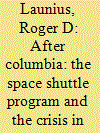

|
|
|
| 2 |
ID:
109156
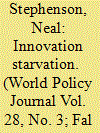

|
|
|
| 3 |
ID:
047224
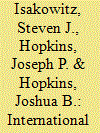

|
|
|
|
|
| Edition |
3rd ed.
|
| Publication |
Reston, American Institute of Aeronautics and Astronautics, 1999.
|
| Description |
xix, 549p.
|
| Standard Number |
1563473534
|
|
|
|
|
|
|
|
|
|
|
|
Copies: C:1/I:0,R:0,Q:0
Circulation
| Accession# | Call# | Current Location | Status | Policy | Location |
| 044132 | 629.41/ISA 044132 | Main | On Shelf | General | |
|
|
|
|
| 4 |
ID:
111262
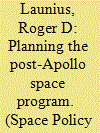

|
|
|
|
|
| Publication |
2012.
|
| Summary/Abstract |
The current debate over the future of human spaceflight in the USA has been a fascinating, and troubling, exercise in futility for those inextricably committed to an expansive vision of human exploration and development of space. The retirement of the Space Shuttle, originally set for the end of 2010 but later extended into 2011, the technical and funding problems of the Constellation follow-on program that led to its cancellation in 2009, and the emergence of commercial vendors who might be able to offer human access to Earth orbit have all complicated the current environment. In view of this situation, the question may be legitimately asked: what might we learn from earlier efforts to develop a human spaceflight capability the last time such a transition took place? Using the post-Apollo transition from the ballistic capsule to a winged, reusable vehicle as a case study, this article seeks to illuminate the planning, decision-making, economic, and political issues that have arisen in this policy debate. It suggests that a web of interlocking issues-only one of which was technical-affected the course taken. Instead, politics, economics, social and cultural priorities, values, and institutional considerations all helped to frame the debate and shape the decision.
|
|
|
|
|
|
|
|
|
|
|
|
|
|
|
|
| 5 |
ID:
100223
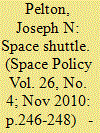

|
|
|
|
|
| Publication |
2010.
|
| Summary/Abstract |
The Space Transportation System (STS), for better or worse, has dominated the US space program for some 30 years and is now an American icon. The Space Shuttle orbiters have flown over 120 missions and certainly accomplished some amazing feats, including the deployment of the International Space Station (ISS), the launch and double repair of the Hubble Telescope, a number of classified missions for the US defense establishment and the cementing of international cooperation in space. As the remaining Space Shuttle orbiters head toward various museums, it is timely to look at the STS program in terms of key US space policy decisions that have paralleled the Space Shuttle's often troubled history. This article seeks, from both a historical and a policy perspective, to assess what might have been. While noting the major accomplishments of the STS, it also identifies what can best be characterized as major lost opportunities and flawed policy decisions that have had multi-billion dollar consequences. In this regard, the US Congress, the White House, and NASA leadership have all played a role. If there have been failings, they have not been by NASA alone, but the entire US space policy leadership.
|
|
|
|
|
|
|
|
|
|
|
|
|
|
|
|
| 6 |
ID:
100222
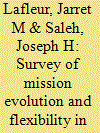

|
|
|
|
|
| Publication |
2010.
|
| Summary/Abstract |
Given the diversity of missions it has accomplished and the myriad of adaptations it has undergone, the US Space Shuttle is widely regarded as a highly flexible space vehicle. With the Shuttle's upcoming 2011 retirement, it is instructive to survey the history of this vehicle's flexibility for the insights it can provide to the design and characterization of flexibility in future space systems. Data are presented on the evolution of mission requirements over time for 120 missions performed by the Space Shuttle over a period of some 27 years. Distinct trends in the time domain - as well as their causes - are identified and discussed, and early manifest plans from 1982 serve as a confirmation that these trends were not originally anticipated. Eight examples are then presented of engineering modifications that allowed the Shuttle to adapt and accommodate these requirement changes. Several additional instances of Shuttle flexibility are explored, such as post-Columbia disaster modification, upgrade programs and derived vehicles, and one case in which flexibility was inhibited by an early design decision.
|
|
|
|
|
|
|
|
|
|
|
|
|
|
|
|
| 7 |
ID:
142552
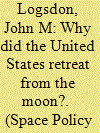

|
|
|
|
|
| Summary/Abstract |
On July 20, 1969, Neil Armstrong and Buzz Aldrin took the first human steps on a celestial body other than Earth. Just over two weeks later, on August 4, NASA presented to a committee charged with making recommendations on the U.S. post-Apollo space program a bold plan of continued lunar and Martian exploration. Over the next six months, that plan was decisively rejected by the administration of President Richard M. Nixon. In 1970, NASA canceled the final two Apollo missions to the Moon, and on January 5, 1972, President Nixon announced approval of the space shuttle program. Focusing the U.S. space program on operating the space shuttle and building a space station has kept the United States human space flight program confined to low Earth orbit for over four decades. There are lessons to be learned from the post-Apollo decisions in the United States for today's attempts to gain political support for a renewed and sustainable program of human exploration of the Moon, Mars, and other solar system destinations. This paper, drawing on in-depth research on the events of the 1969–1972 period in U.S. space policy, will discuss those lessons.
|
|
|
|
|
|
|
|
|
|
|
|
|
|
|
|
|
|
|
|
|